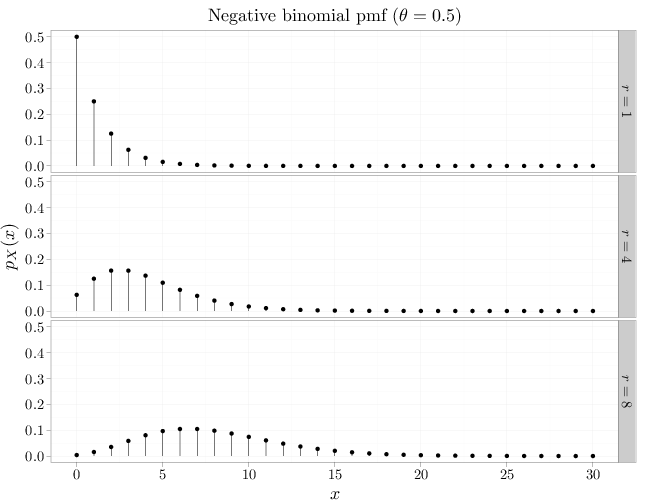3.5. The Negative Binomial Distribution
The negative binomial RV, $X\sim NB(r,\theta)$, where $r\in\mathbb{N}\cup\{0\}, \theta\in[0,1]$, is the number of successes in an infinite sequence of independent Bernoulli experiments before encountering $r$ failures.
The mass function of $X\sim NB(r,\theta)$ is \begin{align} p_X(x) = \begin{cases} \begin{pmatrix} x+r-1\\x \end{pmatrix} (1-\theta)^r \theta^x & x\in\mathbb{N}\cup\{0\}\\ 0 & \text{otherwise}\end{cases}. \end{align}
The above pmf can be derived by noting that there are $\begin{pmatrix} x+r-1\\x \end{pmatrix}$ arrangements of $r$ failures and $x$ successes with the last failure occurring at the end, and that each of the arrangements occur with probability $(1-\theta)^r \theta^x$.
The R code below graphs the pmfs of multiple negative binomial RVs with different parameter values.
theta = 0.5 x = 0:30 D = stack(list(`$r=1$` = dnbinom(x, 1, theta), `$r=4$` = dnbinom(x, 4, theta), `$r=8$` = dnbinom(x, 8, theta))) names(D) = c("mass", "r") D$x = x qplot(x, mass, data = D, geom = "point", stat = "identity", facets = r ~ ., xlab = "$x$", ylab = "$p_X(x)$", main = "Negative binomial pmf ($\\theta=0.5$)") + geom_linerange(aes(x = x, ymin = 0, ymax = mass))
